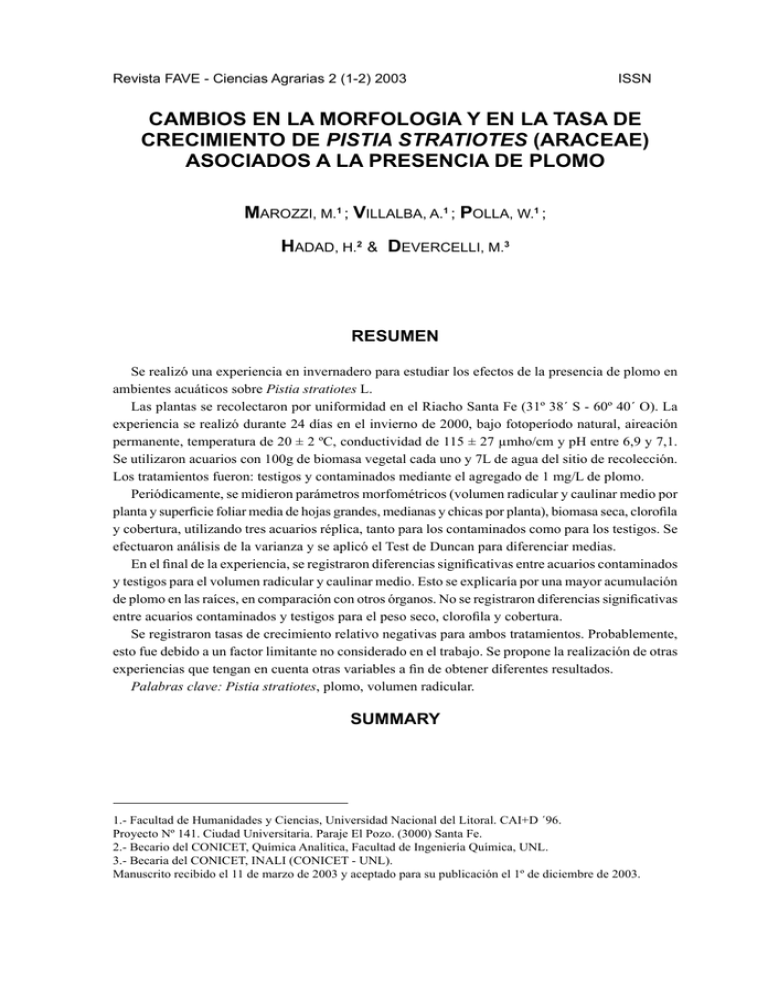asociados a la presencia de plomo - Biblioteca Virtual
Anuncio

Revista FAVE - Ciencias Agrarias 2 (1-2) 2003 ISSN CAMBIOS EN LA MORFOLOGIA Y EN LA TASA DE CRECIMIENTO DE PISTIA STRATIOTES (ARACEAE) ASOCIADOS A LA PRESENCIA DE PLOMO MAROZZI, M.1 ; VILLALBA, A.1 ; POLLA, W.1 ; HADAD, H.2 & DEVERCELLI, M.3 RESUMEN Se realizó una experiencia en invernadero para estudiar los efectos de la presencia de plomo en ambientes acuáticos sobre Pistia stratiotes L. Las plantas se recolectaron por uniformidad en el Riacho Santa Fe (31º 38´ S - 60º 40´ O). La experiencia se realizó durante 24 días en el invierno de 2000, bajo fotoperíodo natural, aireación permanente, temperatura de 20 ± 2 ºC, conductividad de 115 ± 27 µmho/cm y pH entre 6,9 y 7,1. Se utilizaron acuarios con 100g de biomasa vegetal cada uno y 7L de agua del sitio de recolección. Los tratamientos fueron: testigos y contaminados mediante el agregado de 1 mg/L de plomo. Periódicamente, se midieron parámetros morfométricos (volumen radicular y caulinar medio por planta y superficie foliar media de hojas grandes, medianas y chicas por planta), biomasa seca, clorofila y cobertura, utilizando tres acuarios réplica, tanto para los contaminados como para los testigos. Se efectuaron análisis de la varianza y se aplicó el Test de Duncan para diferenciar medias. En el final de la experiencia, se registraron diferencias significativas entre acuarios contaminados y testigos para el volumen radicular y caulinar medio. Esto se explicaría por una mayor acumulación de plomo en las raíces, en comparación con otros órganos. No se registraron diferencias significativas entre acuarios contaminados y testigos para el peso seco, clorofila y cobertura. Se registraron tasas de crecimiento relativo negativas para ambos tratamientos. Probablemente, esto fue debido a un factor limitante no considerado en el trabajo. Se propone la realización de otras experiencias que tengan en cuenta otras variables a fin de obtener diferentes resultados. Palabras clave: Pistia stratiotes, plomo, volumen radicular. SUMMARY 1.- Facultad de Humanidades y Ciencias, Universidad Nacional del Litoral. CAI+D ´96. Proyecto Nº 141. Ciudad Universitaria. Paraje El Pozo. (3000) Santa Fe. 2.- Becario del CONICET, Química Analítica, Facultad de Ingeniería Química, UNL. 3.- Becaria del CONICET, INALI (CONICET - UNL). Manuscrito recibido el 11 de marzo de 2003 y aceptado para su publicación el 1º de diciembre de 2003. M. Marozzi et al. Changes on morphology and rate growth of Pistia Stratiotes (Araceae) Related to lead presence. To study the effects of lead on Pistia stratiotes L. in aquatic environments, a greenhouse experiment was carried out. The plants were collected by similarity in the Santa Fe River (31º 38´ S - 60º 40´W). The experiment lasted 24 days during winter of 2000. It was done under natural photoperiod and permanent airing. The water temperature was 20 ± 2 ºC, the conductivity was 115 ± 27 µmho/ cm and the pH was ranged between 6,9 and 7,1. Containers with 100g of plants and 7L of river water were used. The treatments were: control and polluted containers with 1 mg Pb/L. Periodically, morph-metric parameters (root and steam mean volumes and mean foliar area by plant of large, medium and small leaves), dry biomass, clorophyll and cover were measured in polluted and control containers replicated three times. Variance analyses were carried out and Duncan’s Test was applied for means differentiation. At the end of the experiment, significant differences were registered between polluted and control containers for root and steam mean volumes. This fact could be explained by a higher lead accumulation in the roots in comparison with others organs. It not were registered significant diferences between polluted and control containers for dry weight, clorophyll and cover. Negative growth rates for all the tratments were registered. Probably, it was due to a limitant factor not measured in this work. We propose other experiments that consider others variables to obtain different results. Key words: Pistia stratiotes, lead, root volume. 84 | Revista FAVE - Ciencias Agrarias 2 (1-2) 2003
